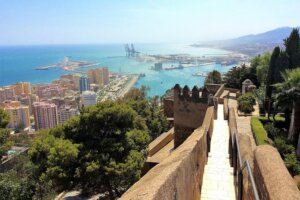Spain is a country that we love. And Andalusia is a dream, especially for those of us who live in climates like Montreal.
In this article we are going to tell you how to have a very good profile of this region of Spain, which is quite responsible for how Spanish is perceived in the world.
This itinerary has been designed to be done with little time -and budget- at our disposal through a well-thought-out and optimized route so as not to miss the main attractions of this region.
Seville
When you arrive in the historic city of Seville, you must take a free walking tour. According to your budget, you can give a tip that will be welcome. These guided walks generally last 2 and a half hours and usually end at noon and leave you in Plaza España, where there are nice restaurants where you can take refuge and have a beer.
In the afternoon visit the magnificent Cathedral of Santa María de la Sede, built between 1401 and 1519 and is one of the largest of the Medieval period. It is a UNESCO Cultural Heritage
Also UNESCO Heritage is the impressive Real Alcázar or Alcázar of Seville. Built from an old Islamic palace, it still serves as the residence of the Royal Family when they visit Seville. Its architecture is impressive, as well as its internal decoration.
The entry prices of these architectural jewels are 12 euros for the Real Alcázar and 9 euros for the Cathedral of the See.
And after those encounters with history and art, nothing better than relaxing at night with the flamenco shows that are unmissable in one of the innumerable bars.
Dedicate your second day in Seville to go to the Torre del Oro naval museum, a military fortress that guarded the entrance to the strategic Guadalquivir River. Built 700 years ago, it also served as a prison.
Grenade
In Seville you can take a bus that takes you to the no less historic city of Granada. You can also rent a car, but it will be more expensive.
The bus ride takes about 3 hours. Try to stay in the center of the city, since from there you will have easy access to the main attractions.
The Cathedral of Granada was built at the beginning of the 16th century in Renaissance style over the old Middle Mosque, once Granada fell into Christian hands. From here, visit the Mirador de San Nicolas to enjoy magnificent views of the Alhambra and the beautiful Andalusian sunsets.
The next day you should take the whole day to visit the star of the city: the Alhambra and its adjacent gardens of El Generalife. The entrance is about 14 euros and we recommend that you book in advance.
Built during the 14th century, it was completed in 1333 and served as a palace for Muslim rulers until Granda fell to Christian power during the Reconquest in 1492.
It was then the Palace of the Catholic Monarchs and it was here that they received Christopher Columbus and gave him the approval for the project of discovery of him.
This architectural jewel and UNESCO monument presents a combination of the Peninsular Arabic style and European elements from the 16th century. Its courtyards, decorations and gardens are of a magnetic beauty.
The Generalife is a villa with impressive gardens adjacent to the Alhambra. It served as a resting place for Islamic rulers. Its gardens and fountains are very beautiful.
Cordova
For our next stop it will take another three hours to reach Córdoba.
There you can visit the Cathedral-Mosque. The entrance to “the mosque” from 8:30 to 9:00 a.m. It’s free. The rest of the hours is 10 euros. It is worth getting up early …
The Mosque Cathedral has the official name of the Cathedral of Our Lady of the Assumption. It is an old mosque built in the 8th century and converted into a Christian temple in 1236, after the conquest of Córdoba by the Christians.
Then, visit the Jewish Quarter or La Judería, where the Jews lived for five centuries until the 15th century. Walk the “Callejuela de las Flores” whose balconies overlook beautifully decorated with flower boxes full of flowers. It is a pleasure to look at.
Then, you must go to the Alcázar de los Reyes Cristianos. Of course, it is another UNESCO Heritage monument built 700 years ago by Alfonso XI and which served as the residence of the Catholic Monarchs.
The nightlife in Córdoba, as in all Andalusia, is quite lively. In the evening you can go for tapas. There are many bars and the usual thing is that you walk all night through different places to try their tapas and their different drinks from one place to another.
Malaga
The last stop on our itinerary will be Pablo Picasso’s hometown: Malaga.
This ancient city was founded by the Phoenicians 2,200 years ago. Today it is a vibrant city brimming with cultural and economic life.
To get to Malaga is to visit the historic center from Plaza Constitución, the heart of the city, to Calle Marqués de Larios. Tom
tie up your time to go through it.
If you like museums, be sure to visit the Carmen Thyssen Museum, focused on 19th century Spanish painting, and, of course, the Picasso Museum, which has almost 300 works by the artist donated by different members of the Picasso family.
The next day you have to go to the port of Malaga, from El Palmeral to pier no. 1. The view of the boats from the restaurants on the boulevard is worth appreciating.
Other interesting places are the Plaza del Obispo with its Cathedral and the Atarazanas Market, with all the marine products of the Costa del Sol.
On the third day, climb the 130 meters of Mount Gibralfaro, at the top of which is Castillo de Gibralfaro, from which you can see an impressive view of Malaga and the Mediterranean.
Conclusions
 The warmth of Andalusia is only comparable to the warmth of its people.
The warmth of Andalusia is only comparable to the warmth of its people.If you visit the region in summer, you must be prepared to withstand daily temperatures of more than 32 degrees, so being prepared with good hydration is essential.
As Latin Americans, you adapt very quickly and feel, in a way, at home. After all, the conquest expeditions to America left the ports of Andalusia.




